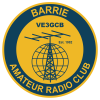What is A.R.E.S.?
Amateur Radio Emergency Service (ARES, pronounced AIR-EEZ) is a public service organization that delivers communications services during emergencies. ARES provides qualified communications personnel who establish ad-hoc radio communications links where and when they are needed.
ARES may be defined as the emergency public service arm of Radio Amateurs of Canada (RAC), and in the US, the Amateur Radio Relay League (ARRL). Its purpose is to advance the public interest and the interests of amateur radio by providing a volunteer emergency telecommunications service to federal, provincial, municipal, or other local government departments and agencies, designated non-government organizations (NGO) and critical public utilities during an emergency or disaster, including necessary training and incidental activities.
ARES does not typically replace the communications infrastructure used by police or other emergency responders, or the systems in place to support agencies and recovery organizations. Instead, it augments existing communications infrastructure, providing added flexibility and capacity that is often needed during emergencies (for example, between emergency operations centers, community shelters, hospitals, evacuation points, and other facilities).
Major Roles
• Mitigation of telecommunications failures
• Supplementary telecommunications support or augmentation
• Command and control level interoperability (for example, communications from a command post to an EOC and between EOCs)
• Special assignments such as observation and reporting.
Meetings
There is a Public Service Communications / ARES meeting at Barrie Fire Hall #1 (intersection of Dunlop Street West and Eccles Street) at 7 PM usually on the first Tuesday of each month. If you want to learn more about Public Service Communications activities and ARES, please come and join us. Talk-in is on the VE3RAG club repeater (if the door is locked, give a call on the repeater).
History
ARES was created by the ARRL in 1935. ARES was subsequently embraced by Radio Amateurs in Canada first under sponsorship by the Canadian Radio Relay League (CRRL) and then by the Radio Amateurs of Canada Inc. (when that body was created out of the CRRL and the Canadian Amateur Radio Federation in 1993).
In 1980, Radio Amateurs in Canada agreed to provide communications for the Canadian Red Cross. This agreement was put in place following successful cooperation during the Mississauga train derailment and evacuation.
ARES and the National Traffic System (NTS), which was part of the CRRL, now operate under the auspices of RAC's Field Services Organization. In fact, ARES operates under the guidance of RAC using a structure parallel to that used in the US. ARES management and ARES emergency coordinators (EC) must be RAC members.
Radio amateurs volunteer their time, expertise and equipment by registering as members of the ARES and providing communications when needed during time of disaster or emergency. There are now more than 70,000 ARES members throughout North America.
Participate
We're called "amateurs" because we are not paid. Our services are provided at no charge. Like amateur sports, we do it for the love of it! We may be called "amateurs," but our communications services are professional.
Taking part in the ARES program:
• Having a genuine desire to assist your Community
• Attending ARES meetings
• Participating in Community service events and simulated exercises
• Checking into nets
• Getting involved in ARES training and help training others
